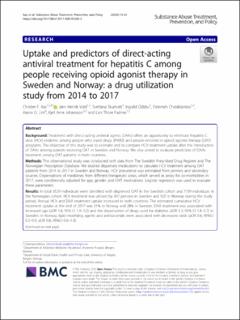| dc.contributor.author | Aas, Christer Frode | |
| dc.contributor.author | Vold, Jørn Henrik | |
| dc.contributor.author | Skurtveit, Svetlana | |
| dc.contributor.author | Odsbu, Ingvild | |
| dc.contributor.author | Chalabianloo, Fatemeh | |
| dc.contributor.author | Lim, Aaron G. | |
| dc.contributor.author | Johansson, Kjell Arne | |
| dc.contributor.author | Fadnes, Lars T. | |
| dc.date.accessioned | 2021-05-04T06:48:42Z | |
| dc.date.available | 2021-05-04T06:48:42Z | |
| dc.date.created | 2021-02-03T11:55:34Z | |
| dc.date.issued | 2020 | |
| dc.identifier.issn | 1747-597X | |
| dc.identifier.uri | https://hdl.handle.net/11250/2753375 | |
| dc.description.abstract | Background
Treatment with direct-acting antiviral agents (DAAs) offers an opportunity to eliminate hepatitis C virus (HCV) endemic among people who inject drugs (PWID) and people enrolled in opioid agonist therapy (OAT) programs. The objective of this study was to estimate and to compare HCV treatment uptake after the introduction of DAAs among patients receiving OAT in Sweden and Norway. We also aimed to evaluate predictors of DAAs treatment among OAT patients in both countries.
Methods
This observational study was conducted with data from The Swedish Prescribed Drug Register and The Norwegian Prescription Database. We studied dispensed medications to calculate HCV treatment among OAT patients from 2014 to 2017 in Sweden and Norway. HCV prevalence was estimated from primary and secondary sources. Dispensations of medicines from different therapeutic areas, which served as proxy for co-morbidities in 2017, were conditionally adjusted for age, gender, and OAT medications. Logistic regression was used to evaluate these parameters.
Results
In total 3529 individuals were identified with dispensed OAT in the Swedish cohort and 7739 individuals in the Norwegian cohort. HCV treatment was utilized by 407 persons in Sweden and 920 in Norway during the study period. Annual HCV and DAA treatment uptake increased in both countries. The estimated cumulative HCV treatment uptake at the end of 2017 was 31% in Norway and 28% in Sweden. DAA treatment was associated with increased age (aOR 1.8; 95% CI 1.0–3.2) and the dispensation of drugs used for diabetes (aOR 3.2; 95% CI 1.8–5.7) in Sweden. In Norway, lipid modifying agents and antibacterials were associated with decreased odds (aOR 0.4; 95%CI 0.2–0.9, aOR 0.8; 95%CI 0.6–1.0).
Conclusions
An increase in DAA treatment and HCV treatment uptake was observed among Swedish and Norwegian OAT patients whilst introducing new direct-acting antiviral treatment regimens. However, more than two thirds of the OAT population in Norway and Sweden were untreated at the beginning of 2018. A further scale-up is crucial in order to control and eliminate the HCV endemic among OAT patients. | en_US |
| dc.language.iso | eng | en_US |
| dc.publisher | BMC | en_US |
| dc.rights | Navngivelse 4.0 Internasjonal | * |
| dc.rights.uri | http://creativecommons.org/licenses/by/4.0/deed.no | * |
| dc.title | Uptake and predictors of direct-acting antiviral treatment for hepatitis C among people receiving opioid agonist therapy in Sweden and Norway: a drug utilization study from 2014 to 2017 | en_US |
| dc.type | Journal article | en_US |
| dc.type | Peer reviewed | en_US |
| dc.description.version | publishedVersion | en_US |
| dc.rights.holder | Copyright 2020 The Author(s). | en_US |
| dc.source.articlenumber | 44 | en_US |
| cristin.ispublished | true | |
| cristin.fulltext | original | |
| cristin.qualitycode | 1 | |
| dc.identifier.doi | 10.1186/s13011-020-00286-2 | |
| dc.identifier.cristin | 1886268 | |
| dc.source.journal | Substance Abuse Treatment, Prevention, and Policy | en_US |
| dc.identifier.citation | Substance Abuse Treatment, Prevention, and Policy. 2020, 15, 44 | en_US |
| dc.source.volume | 15 | en_US |

